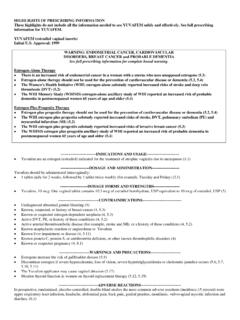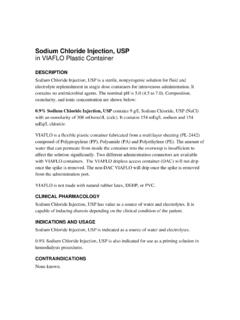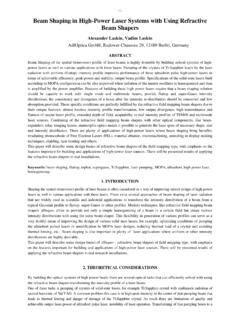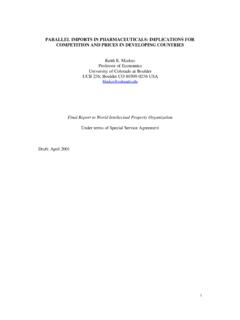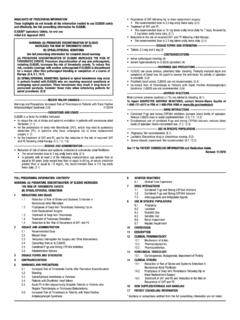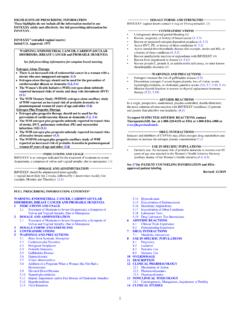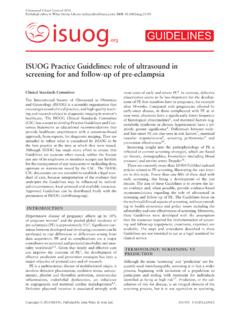Transcription of PRODUCT INFORMATION VALETTE® NAME OF THE MEDICINE
1 180111 Valette PI 1 PRODUCT INFORMATION VALETTE NAME OF THE MEDICINE VALETTE is a combined oral contraceptive (COC) preparation containing the synthetic progestogen, dienogest and the synthetic estrogen, ethinylestradiol as the active substances. Dienogest is a progestogen. The chemical name for dienogest is 17 -cyanomethyl-17 -hydroxy-estra-4,9(10)-dien-3-one and has the following structural formula: OHCH3 OHHCN Chemical formula: C20H25NO2 Molecular weight: Melting point: 210-218oC CAS No.: 65928-58-7 Ethinylestradiol is an estrogen. Chemically, ethinylestradiol is 19-nor-17 -pregna-1,3,5(10)-trien-20-yne-3, 17 diol and has the following structural formula: CH3 OHCCHOHHHH Chemical formula: C20 H24 O2 Molecular weight: Melting point: 181-185oC CAS No.: 57-63-6 180111 Valette PI 2 DESCRIPTION Dienogest is a white to pale yellow crystalline powder: odourless; practically insoluble in water, sparingly soluble in ethanol and acetone, soluble in chloroform.
2 Ethinylestradiol is a white to creamy white, odourless, crystalline powder. It is insoluble in water and soluble in alcohol, chloroform, ether, vegetable oils, and aqueous solutions of alkali hydroxides. Each small white active tablet contains dienogest 2 mg, ethinylestradiol 30 g and the excipients: lactose monohydrate, maize starch, magnesium stearate, sucrose, liquid glucose, calcium carbonate, povidone, macrogol 35000, carnauba wax, maltodextrin and titanium dioxide. Each brown inactive tablet contains lactose monohydrate, maize starch, purified talc, magnesium stearate, povidone, sucrose, macrogol 6000, calcium carbonate, titanium dioxide, glycerol, ferric oxide, glycol montanate. PHARMACOLOGY Pharmacodynamic properties The contraceptive effect of combined oral contraceptives (COCs) is based on the interaction of various factors. The primary mechanisms are inhibition of ovulation (by suppression of gonadotrophins) and changes in the cervical secretion (blocking the entry of sperm into the uterus).
3 As well as protection against pregnancy, combined oral contraceptives have several positive properties which, next to the negative properties (see PRECAUTIONS, ADVERSE EFFECTS), can be useful in deciding on the method of birth control. For the majority of users, the cycle is more regular, the menstruation is often less painful and bleeding is lighter. The latter may result in a decrease in the occurrence of iron deficiency. Dienogest has beneficial properties in addition to contraception. Dienogest exerts antiandrogenic activity leading to a positive effect on the skin and to a reduction in acne lesions and sebum production. In addition, with the higher-dosed COCs (50 g ethinylestradiol), there is evidence of a reduced risk of fibrocystic tumours of the breasts, ovarian cysts, pelvic inflammatory disease, ectopic pregnancy and endometrial and ovarian cancer.
4 Whether this also applies to lower-dosed combined oral contraceptives such as VALETTE remains to be confirmed. Pharmacokinetic properties Bioavailability studies have been conducted with VALETTE. Dienogest Absorption After single oral administration of 2 mg dienogest in combination with 30 g ethinylestradiol, dienogest is absorbed rapidly and almost completely. Maximum plasma concentrations of ng/mL are reached in hours after single dose oral administration. A high absolute bioavailability of about 96% was demonstrated in a bioavailability study. 180111 Valette PI 3 Distribution 10% is present in plasma in free form, whilst approx. 90% is bound non-specifically to albumin. Unlike all other 19-norprogesterones, dienogest does not bind to the specific transport proteins, sex hormone-binding globulin (SHBG) and corticosteroid-binding globulin (CBG).
5 As there is therefore no possibility of testosterone being displaced from its SHBG binding or of cortisols being displaced from its CBG binding, an influence on the physiological transport processes for endogenous steroids is unlikely. The half-life of dienogest is hours, which is relatively short compared to other progestogens. There is thus very little accumulation with daily administration. Metabolism Dienogest is metabolised mainly by hydroxylation but also by hydrogenation, conjugation and aromatisation, to endocrinologically largely inactive metabolites. The contribution of the metabolites to the pharmacological and toxicological effects of dienogest is insignificant. Elimination After an oral dose of mg/kg body weight, the ratio of renal to faecal excretion is The total clearance is L/h after a single dose. Steady state conditions The pharmacokinetics of dienogest is not influenced by SHBG levels.
6 Following daily ingestion, drug serum levels increase about fold reaching steady state conditions after approximately 4 daily administrations. Ethinylestradiol Absorption Orally administered ethinylestradiol is absorbed rapidly in the small intestine. 50-60% of it is converted primarily to sulphate metabolites in the wall of the small intestine and in the liver (first-pass effect). After administration of the ethinylestradiol-dienogest combination, the absolute bioavailability of ethinylestradiol is about 44%. After a single administration of 30 g ethinylestradiol and 2 mg dienogest, maximum plasma concentrations are reached after to 4 hours. Distribution Serum ethinylestradiol levels decrease in two phases, with an elimination half-life of hours following single administration of 30 g ethinylestradiol and 2 mg dienogest. Ethinylestradiol is highly but non-specifically bound to serum albumin (approximately %), and induces an increase in the serum concentrations of SHBG.
7 Metabolism Ethinylestradiol is subject to presystemic conjugation in both small bowel mucosa and the liver. Ethinylestradiol is primarily metabolised by aromatic hydroxylation but a wide variety of hydroxylated and methylated metabolites are formed. These are present as free metabolites and as conjugates with glucuronides and sulphate. The metabolic clearance rate of ethinylestradiol is about 5 mL/min/kg. 180111 Valette PI 4 Elimination Ethinylestradiol is not excreted in unchanged form to any significant extent. The metabolites of ethinylestradiol are excreted 30-50% via the kidneys, with 30-40% being excreted with the faeces. Steady state conditions Steady state conditions are reached during the second half of treatment cycle when serum drug levels are approximately two fold higher than that of a single dose of ethinylestradiol.
8 CLINICAL TRIALS The contraceptive efficacy and safety of VALETTE was examined in two open phase III multicentre studies, the first of which involved 2,290 evaluable women over a period ranging from 1 to 22 cycles, with 1,612 women completing 12 cycles. The second study investigated 97 women up to 12 cycles. The total cycle numbers were 28,183 and 686 respectively. The unadjusted Pearl Index for the first study was ; the adjusted Pearl index was No pregnancies occurred in the second study. Data are also available from two large post-marketing surveillance studies involving 92,146 treatment cycles from 16,087 women and 63474 treatment cycles in 10,718 women. In the first of these studies only 17 pregnancies occurred, 6 after discontinuation. The Pearl index was therefore During the second study only 3 unintended pregnancies occurred, corresponding to an unadjusted Pearl Index of The effects on cycle control displayed in the phase III trials were as expected for a low dose combined oral contraceptive preparation.
9 Intermenstrual bleeding was highest in the first cycle, with cycle stabilisation occurring with treatment duration. In the largest study spotting and breakthrough bleeding had been reduced by 50% after one year of treatment (from in cycle 1 to by cycle 12). The duration of bleeding decreased over the study periods, from days to days and from days to 4 days in the two studies. Dysmenorrhoea, which occurred frequently before treatment (approx. 29%) had decreased so that 93% of women were complaint free by cycle 6 and it occurred only rarely after 12 cycles. Bleeding intensity also decreased under treatment. Prior to treatment reported scanty bleeding and excessive bleeding. By the 6th cycle had scanty, and only 2% excessive bleeding. Acne: A Phase III study (Clinical Research Report No. 28501) investigated the anti-acne effects of VALETTE versus both a placebo control arm and a comparator arm with Diane-35 (ethinylestradiol and cyproterone acetate).
10 The primary efficacy variables were the percentage change from baseline to cycle 6 in inflammatory (papules, pustules, nodules) lesion count, the total lesion count and improvement in facial acne according to the investigator s global assessment (IGA). The hypothesis that VALETTE is superior to placebo and not inferior to Diane -35 would only be correct if all 3 variables met the criteria. The study included 525 women treated with VALETTE, 537 with Diane-35 and 246 with placebo over 6 treatment cycles of 28 days. During the study, subjects were required to refrain from other anti-acne treatments and acne causing medications and comedogenic preparations. The results for the primary efficacy variables (FAS Full Analysis Set) are provided in the Table below: 180111 Valette PI 5 VARIABLE VALETTE PLACEBO DIANE-35 Percent change in total lesion count - - - SD N 515 259 528 Percent changes in inflammatory lesion count - - - SD N 511 257 526 Number & Percent of patients with improvement in facial acne according to IGA 477 ( ) 199 ( ) 480 ( ) The conclusion is that VALETTE is superior to placebo while similar results for all three variables were obtained for the VALETTE and Diane-35 groups leading to the conclusion that VALETTE is not inferior to Diane-35.


